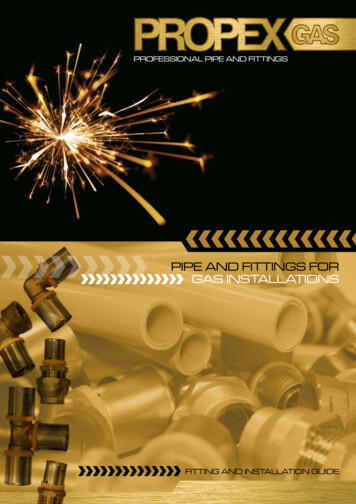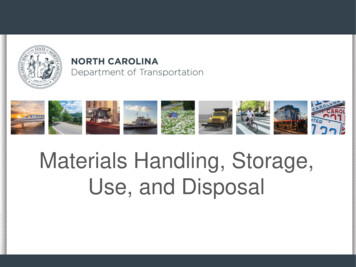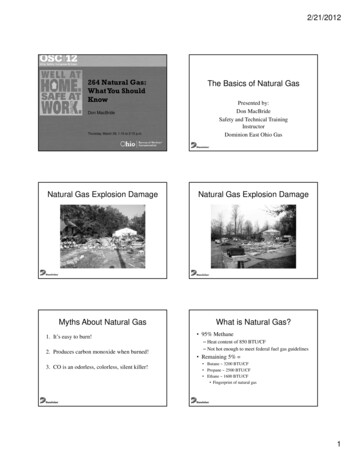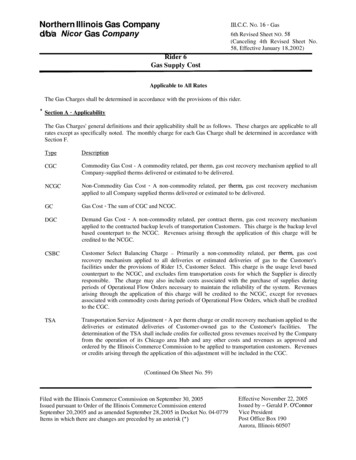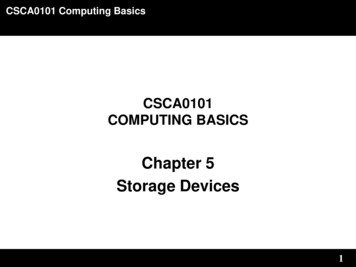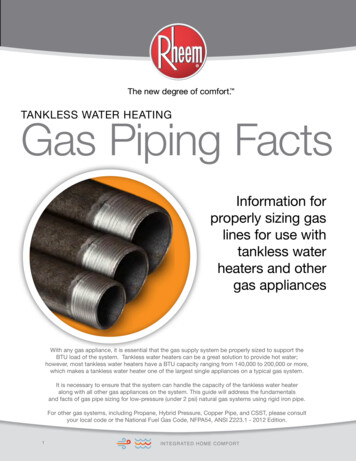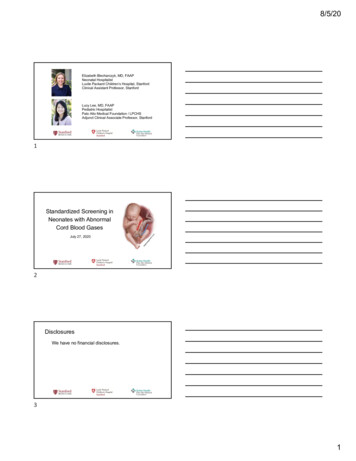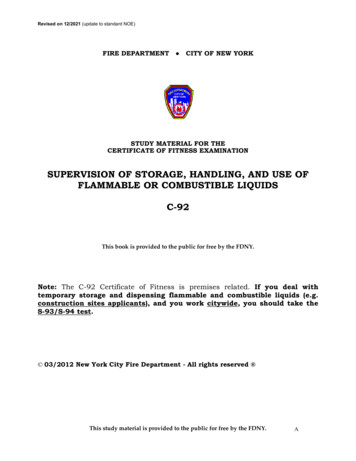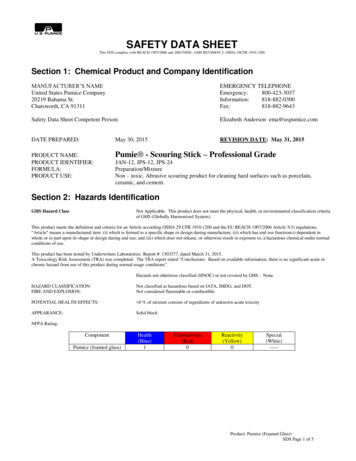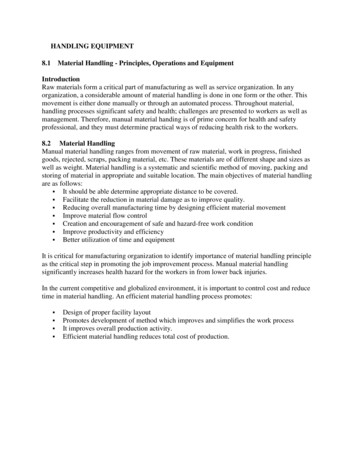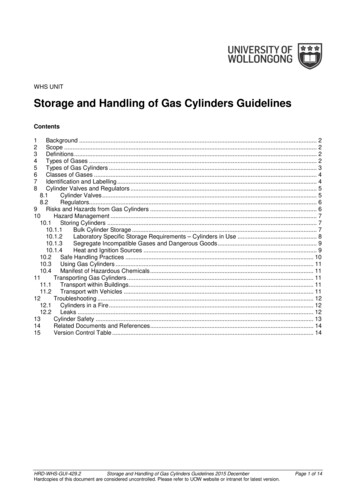
Transcription
WHS UNITStorage and Handling of Gas Cylinders GuidelinesContentsBackground . 2Scope . 2Definitions . 2Types of Gases . 2Types of Gas Cylinders . 3Classes of Gases . 4Identification and Labelling . 4Cylinder Valves and Regulators . 58.1Cylinder Valves . 58.2Regulators. 69 Risks and Hazards from Gas Cylinders . 610Hazard Management . 710.1 Storing Cylinders . 710.1.1Bulk Cylinder Storage . 710.1.2Laboratory Specific Storage Requirements – Cylinders in Use . 810.1.3Segregate Incompatible Gases and Dangerous Goods . 910.1.4Heat and Ignition Sources . 910.2 Safe Handling Practices . 1010.3 Using Gas Cylinders . 1110.4 Manifest of Hazardous Chemicals . 1111Transporting Gas Cylinders . 1111.1 Transport within Buildings. 1111.2 Transport with Vehicles . 1112Troubleshooting . 1212.1 Cylinders in a Fire . 1212.2 Leaks . 1213Cylinder Safety . 1314Related Documents and References . 1415Version Control Table . 1412345678HRD-WHS-GUI-429.2Storage and Handling of Gas Cylinders Guidelines 2015 DecemberHardcopies of this document are considered uncontrolled. Please refer to UOW website or intranet for latest version.Page 1 of 14
Storage and Handling of Gas Cylinders Guidelines1BackgroundThis document provides basic guidance on the safe storage and handling of compressed gascylinders. These guidelines need to be followed in order to protect people, property and theenvironment from emergencies involving gas cylinders as well as ensuring compliance withrelevant legislation.2ScopeThese guidelines apply to all workers and others who store and handle gas cylinders at theUniversity of Wollongong.3DefinitionsAsphyxiationBreathing difficulties (suffocation), loss of consciousness and eventualdeath caused by an inadequate supply of oxygen to the body.Flammable gasA gas that can be ignited in air.Inert or Noble gasAny of the six gases helium, neon, argon, krypton, xenon, and radon.These gases are un-reactive except under certain special conditions.Non-flammable gasA gas that is neither flammable nor poisonous but can still causeasphyxia and death.Oxidizing gasA gas that initiates or promotes combustion of materials throughrelease of oxygen.These gases can also spontaneouslycombust/explode.Short Term ExposureLimit (STEL)Maximum concentration of a gas that a person can be exposed to for a15 minute period. Only 4 such exposure periods can occur within an 8hour day and 1 hour break is required between exposure intervals.Time WeightedExposure Limit (TWA)Maximum concentration of a gas that a person can be exposed to for 8hours per day over a 5 day working week.Toxic gasA gas that is poisonous or capable of causing injury or death, especiallyby chemical means.Upper and LowerExplosive Limits (UELand LEL)Upper and lower concentration (in %) limits for which a particular gas isexplosive in air.4Types of GasesThere are three types of gases commonly supplied and used:1. Compressed Gases – Nitrogen, Oxygen, Air, Carbon Dioxide, Helium2. Liquefied Gases – LPG, Liquefied Nitrous Oxide3. Dissolved Gases – AcetyleneCryogenic vapour could also be considered as a gas but is dealt with in a separate document.Refer to Storage, Transport and Handling of Cryogens Guidelines for information on vapour fromcryogens.HRD-WHS-GUI-429.2Storage and Handling of Gas Cylinders Guidelines 2015 DecemberPage 2 of 14Hardcopies of this document are considered uncontrolled. Please refer to UOW website or intranet for latest version.
Storage and Handling of Gas Cylinders Guidelines5Types of Gas CylindersIn general, there are three types of gas cylinders:1. High Pressure Cylinders – High pressure cylinders come in a variety of sizes, see Figure 1.Some examples of gases supplied in High pressure cylinders include Nitrogen, Helium,Hydrogen, Oxygen and Carbon Dioxide.2. Low Pressure Cylinders – Low pressure cylinders come in a variety of sizes, see Figure 2.Some examples of gases supplied in low pressure cylinder are LPG and refrigerant gases.3. Acetylene Cylinders – aggregate filled and acetylene is dissolved in acetone to getsufficient product into the cylinder. See Figure 3.Acetylene is in a class of its own as the cylinder is filled with an aggregate material and dissolvedin a liquid medium (acetone).Figure 1: Size range of high pressure gas cylinders availableFigure 2 Size Range of low pressure gas cylinders availableFigure 3 Size Range of Acetylene cylinders AvailableHRD-WHS-GUI-429.2Storage and Handling of Gas Cylinders Guidelines 2015 DecemberPage 3 of 14Hardcopies of this document are considered uncontrolled. Please refer to UOW website or intranet for latest version.
Storage and Handling of Gas Cylinders Guidelines6Classes of GasesThe following table shows the four main classes of gases. Gases can also have corrosiveproperties, eg Ammonia. The class of gas defines its physical properties and transportrequirements. However, it is also important for considering storage and handling/usagerequirements.Dangerous GoodsDiamond7ClassExamplesClass 2.1 Flammable gasLPG, hydrogen, acetyleneClass 2.2 Non-flammable, non-toxicgasesCompressed air, nitrogen,argon, carbon dioxide, helium.Class 2.2, Sub-risk 5.1 Oxidizing gasOxygen, nitrous oxide, Entonox(50% oxygen, 50% nitrousoxide).Class 2.3 Toxic GasMethyl bromide, anhydrousammonia, chlorine.Identification and LabellingGas cylinders are required to be labelled with the following: Class label and any subsidiary risk labelsThe proper shipping nameA four digit United Nations numberManufacturer/importer’s nameCylinder sizes are denoted by a letter code. The gas content of cylinders is measured in cubicmetres, litres or kilograms. If volume unit is given, it refers to standard temperature and pressureof 15 C (101.3 kPa).Figure 4 Typical Gas Cylinder Label InformationHRD-WHS-GUI-429.2Storage and Handling of Gas Cylinders Guidelines 2015 DecemberPage 4 of 14Hardcopies of this document are considered uncontrolled. Please refer to UOW website or intranet for latest version.
Storage and Handling of Gas Cylinders GuidelinesProtect the markings on cylinders that identify the contents, and mark the full/empty status oncylinders. Manufacturers paint gas cylinders using a colour coded system that is useful foridentification. You should consult the manufacturer’s product catalogues for colour charts with thisinformation.NEVER alter markings, labelling or colour coding of gas cylinders supplied. They are a rented itemand should be treated as such. The integrity and compliance of the gas cylinder is the supplier’sresponsibility.NOTE: All gas cylinders are also fitted with a barcode by the supplier for tracking purposes. The barcodeshould not be tampered with or removed. The barcode is scanned by the supplier on supply of the cylinderand also again upon return and identifies who has used the cylinder, the time period it has been used for andthe rental charges to be paid by the user. If the barcode is removed or can’t be scanned on return to thesupplier additional rental charges could be incurred and these could be substantial. Furthermore, if thesupplier has no record of the cylinder been returned this could be considered as theft.8Cylinder Valves and Regulators8.1Cylinder ValvesThe gas cylinder valve is the primary safety mechanism on a gas cylinder and shall not betampered with. It is a device used to contain the contents of the cylinder that is under pressure.Cylinder valves are fitted with pressure relief valves of different types (depending on the cylinder)to protect against catastrophic failure of the cylinder valve. Figure 5 & Figure 6 show differenttypes of cylinder valves and pressure relief devices respectively.Figure 5 Examples of Typical Gas Cylinder ValvesFigure 6 Typical pressure relief devices fitted to cylinder valves. Top Left - Integrated regulator type for 300 atmscylinders, Burst disc type, Fusible plug type, STD pressure relief valve.NOTE:Cylinder valves on flammable gases have a left hand thread to attach the regulator.This is to distinguish them from non-flammable gases.The thread size of an Air or Nitrogen cylinder valve differs from Oxygen so that theycannot be mistaken in medical applications.HRD-WHS-GUI-429.2Storage and Handling of Gas Cylinders Guidelines 2015 DecemberPage 5 of 14Hardcopies of this document are considered uncontrolled. Please refer to UOW website or intranet for latest version.
Storage and Handling of Gas Cylinders GuidelinesCylinder valves open in an anticlockwise direction and close in a clockwise direction. Valves shallnever be opened without a regulator attached. Always open cylinder valves slowly. Figure 7shows the operation of the cylinder valve.Figure 7 Correct operation of gas cylinder head valve tap8.2RegulatorsThe regulator is the next most important safety device to be fitted to a gas cylinder beforeoperation/use. It allows for the high pressure of the cylinder contents to be brought down to ausable working pressure. Regulators come as single stage for short term applications and twostages for long term applications. Regulators are also constructed from different materials, mainlybrass or stainless steel.The application will define the required regulator. If you are unsure of which kind of regulator touse, consult your gas supplier.Regulators are designed to be fitted directly to the cylinder valve. No other fittings, connections orlubricants shall be used to connect a regulator to a gas cylinder valve.Regulators for flammable gases are left hand threaded and have a notch cut out of faces on thesecuring nut to distinguish them from non-flammable gas regulators.9Risks and Hazards from Gas CylindersGas cylinders can be hazardous due to both their physical (size and weight) and chemicalcharacteristics. Hazards from gases are also subject to the chemical properties of each gas.These may be one or more of the following: Fire or explosion from the release of flammable gases near ignition sources (e.g. acetyleneor LPG). Refer to SDS for Upper and Lower Explosive Limits (UEL and LEL)Spontaneous combustion from oxidizing gases (e.g. oxygen or nitrous oxide)Exposure limits for all gases, especially toxic or corrosive gases (e.g. anhydrous ammonia);refer to SDS for Time Weighted Exposure Limit (TWA) and Short Term Exposure Limit(STEL)Asphyxiation from non-toxic, non-flammable gases by displacement of oxygen (e.g.nitrogen, carbon dioxide or argon)Incorrect storageLeaksFaulty equipment/connectionsHRD-WHS-GUI-429.2Storage and Handling of Gas Cylinders Guidelines 2015 DecemberPage 6 of 14Hardcopies of this document are considered uncontrolled. Please refer to UOW website or intranet for latest version.
Storage and Handling of Gas Cylinders Guidelines Physical risksManual handlingSudden release of gas if cylinder is damaged (torpedo effect).Pressure – compressed gas cylinders are filled to a pressure of 200-300 atmospheresGas DensityRead, understand, and follow the markings on the cylinder, the label(s) on the cylinder, and thesafety data sheet (SDS) to avoid misuse. The SDS must be read to identify: Chemical and physical hazards for each gas cylinderAppropriate safe storage and handling practicesThe need for additional control measuresFirst aid measuresFire-fighting and emergency informationDensity of the gasExposure limitsFlammability/explosivenessTransport requirementsEach compressed gas cylinder has unique hazards based on its contents. Some are filled withinert gases – especially those used in arc welding. Many gases are flammable, explosive, toxic, ora combination.NOTE: When gases are released and expand, a drop in temperature occurs. In somecases (e.g. carbon dioxide) the rapid release and expansion of gas can cause a coldhazard (e.g. frostbite) to exposed persons.10Hazard ManagementThe below information outlines controls to be implemented for pre-identified hazards relating to gascylinders. If further hazards are identified (e.g. local hazards) then a risk assessment must becarried out and recorded to identify hazards and the need for any additional control measures.Safe Work Procedures shall be developed for tasks that routinely involve the use and handling ofgases from pressurised cylinders.Anyone working with gas cylinders needs to be given information, training and effective supervisionregarding the hazards from gas cylinders, safe storage and handling information and what to do inan emergency.10.1Storing Cylinders10.1.1 Bulk Cylinder StorageGas stores should be located outdoors, preferably in a secure, cage protected from sunlight.Storage indoors is not recommended unless the building has been designed for that purpose withappropriate fire rated walls and ventilation. Where gases are stored indoors, additional safetyconsiderations and control measures need to be given consideration.It is recommended that if you store significant quantities of gas in cylinders that you consult AS4332 - The Storage and Handling of Gases in Cylinders for guidance, or consider the services of adangerous goods consultant.HRD-WHS-GUI-429.2Storage and Handling of Gas Cylinders Guidelines 2015 DecemberPage 7 of 14Hardcopies of this document are considered uncontrolled. Please refer to UOW website or intranet for latest version.
Storage and Handling of Gas Cylinders GuidelinesFigure 8 Example of a bulk storage location for cylinders at UOW Wollongong Campus10.1.2 Laboratory Specific Storage Requirements – Cylinders in UseStore cylinders in an upright position 1. If cylinders have been lying on their side, place the cylinderin the upright position and wait 60 minutes before using. If Acetylene has been laid on its side,then it is recommended that the cylinder is not used for 12-24 hours.Secure cylinders using a purpose built non-abrasive coated chain, strap or cable that will notscratch the cylinder markings and paint work or a racking system. Refer Figure 9.Figure 9 Cylinder secured by wall bracketsCompletely close the valves, and keep the valve protection devices, such as caps or guards,securely in place when cylinder is not in use. Store cylinders in a dry, well-ventilated area. Place them in a location where they will not be subject to mechanical or physical damage,heat, or electrical circuits to prevent possible explosion or fire. Keep cylinders away frompedestrian traffic. Full and empty cylinders should be stored separately in clearly marked areas. Objects should not be stored on top of gas cylinders.1Some cylinders are designed to be stored on their side. Consult the SDS or contact the supplier for additionalinformation.HRD-WHS-GUI-429.2Storage and Handling of Gas Cylinders Guidelines 2015 DecemberPage 8 of 14Hardcopies of this document are considered uncontrolled. Please refer to UOW website or intranet for latest version.
Storage and Handling of Gas Cylinders Guidelines Gases denser than air need to be stored with caution to avoid storage where these gasescan collect in low lying areas.Gas cylinders should not be located where they may block stairs, exits, ladders or walkways.Ensure an up to date and accurate inventory is kept. Keep inventory quantities as low aspossible.Avoid storing cylinders below 0oC. Some mixtures may separate below this.Laboratory storage locations should be positioned as close to the usage point as possible.10.1.3 Segregate Incompatible Gases and Dangerous GoodsCorrosive liquids can damage gas cylinders on contact. Flammable liquids can spread a fireacross a workplace floor and allow flames to come into contact with gas cylinders. Otherdangerous goods may also be adversely affected by gas cylinders in an emergency. For thisreason, gas cylinders are kept separately from other dangerous goods and combustible liquids byat least 5m or by using appropriate fire rated barriers. Segregation of incompatible goods alsoallows fire fighters to safely use appropriate fire-fighting media for each type of goods present.Gas cylinders must also be segregated from other incompatible gases by at least 3 m. Thefollowing is recommended: Class 2.3 “Toxic gas” and corrosive gases (subsidiary risk of Class 8 “Corrosive”) arestored away from all other gas cylinders.Class 2.1 “Flammable gas” shall not be stored with subsidiary risk class 5.1 gases oroxygen.Keep oxygen cylinders five metres away from other dangerous goods (e.g. Class 3, 4, 5,6.1, 7, 8 or 9, etc) and combustible liquids (e.g. diesel fuel, acetylene), or separate themwith a non-combustible barrier (such as a wall) at least one metre higher than the tallestcylinder with a fire-resistance rating of at least half an hour.Ensure gas cylinders are stored at least three metres away from combustible materials anddebris (e.g. timber, card board, packaging materials) to prevent flame impingement on gascylinders in a fire.Mutually compatible gases (e.g. Class 2.2, without subsidiary risk) may be placed betweenincompatible gases.10.1.4 Heat and Ignition SourcesHeating of the cylinder (e.g. from fire) or impact to the pressure vessel wall may result in explosionand shrapnel hazard to exposed persons. DO NOT use oil or grease on the valve of a cylinders or regulators/gauges, particularlythose containing oxygen or oxidising agents, to avoid fire or explosion.Store cylinders in cool areas away from sources of radiant heat (e.g. boilers, hot surfaces,and internal combustion engines). Where possible, store cylinders in the shade to avoidexposing cylinders to direct sunlight.Cylinders containing flammable gas should not be stored near sources of ignition such asnaked lights / flames, cigarette smokers, etc.For flammable gas storage, appropriate signs stating “No Smoking”, “No Naked Lights”should be erected to preclude ignition sources from these areas.All gas cylinders should be fitted with a test tag that is heat sensitive. DO NOT use a cylinder ifthe test tag is missing or shows evidence of heat exposure.HRD-WHS-GUI-429.2Storage and Handling of Gas Cylinders Guidelines 2015 DecemberPage 9 of 14Hardcopies of this document are considered uncontrolled. Please refer to UOW website or intranet for latest version.
Storage and Handling of Gas Cylinders GuidelinesFigure 10 Normal and heat effected test tags10.2Safe Handling PracticesMost accidents or injuries involving cylinders happen when moving or handling the gas cylinders.Large gas cylinders (e.g. G or F sized cylinders) can be bulky, heavy, and awkward to handle, theyrequire special care and equipment in handling and securing so they don’t fall or tip over andcause injury.Anyone involved in the handling of gas cylinders should undertake some basic induction training orhave read the Safe Work Procedures relating to the transport, storage and use of Gas Cylinders.Wear protective footwear, safety glasses. Gloves are also recommended.Securely install the valve protection devices when the cylinder is not in use, such as caps orguards. EXEMPTION: G size cylinders will not have a protective cap or guard fitted.When moving cylinders, DO NOT roll or drag them. Ensure that an appropriate mechanicalhandling device is used (Figure 11). Secure cylinders upright to a proper hand truck or cylindercart with a restraining strap designed for the purpose. Cylinder size E and greater shall be handledusing mechanical assistance.Figure 11 Mechanical handling devicesContact your gas supplier if more sophisticated handling of cylinders is required.DO NOT lift by the protective cap. If a cylinder does not have a handle then use mechanicalassistance to move it.DO NOT restrain cylinders around their necks or valve – restrain them around the main cylinderbody at a height that will prevent them from falling over, i.e. 1/2 to 2/3 the height of the cylinder.Avoid dropping or knocking cylinders about. Prevent damage to cylinders from impact from otherobjects (e.g. crashing into other cylinders). Some cylinders (e.g. acetylene) may react violentlyafter being excessively shaken, heated, or knocked.Cylinders should NEVER be used as rollers to move other objects.HRD-WHS-GUI-429.2Storage and Handling of Gas Cylinders Guidelines 2015 DecemberPage 10 of 14Hardcopies of this document are considered uncontrolled. Please refer to UOW website or intranet for latest version.
Storage and Handling of Gas Cylinders Guidelines10.3 Using Gas CylindersAlways use gas cylinders in well ventilated areas. DO NOT use gas cylinders in confinedspaces unless qualified to do so and the appropriate PPE is used.Know the gas you are using and possible reaction products. Additional mechanicalventilation may be required. Seek expert assistance in designing and installing mechanicalventilation systems.Ensure the correct regulator is used for the purpose.Ensure there is a suitable emergency response procedure in place.Wear appropriate PPE for the gas been used, refer to SDS.Ensure connections, fittings and lines are leak tight and suitable for use.Ensure that flammable and oxidising gases are not used near ignition sources.Disconnect empty cylinders from equipment to avoid backflow issuesAlways close the cylinder valve when not in use.DO NOT use an empty cylinder as a waste receptacle.Fit non-return valves in line if requiredDO NOT use a gas cylinder that shows evidence of damage or corrosion. The gas cylinderis a rented item; its integrity is the responsibility of the gas supplier.If the cylinder contents cannot be clearly identified, DO NOT use it. Return it to thesupplier.NOTE: If a cylinder shows frosting around the valve than the flow through thesystem is too high or there is a significant leak in the system. If a high flow rateoption is required, consult your gas supplier for the best solution. For information onhandling leaks refer to section 12.2.10.4Manifest of Hazardous ChemicalsRequirements for management of placarding and manifest quantities of hazardous chemicals (including gascylinders) is outlined in the Dangerous Goods Storage and Handling Guidelines. This includes a list ofstorage areas (including contents and quantities), site plan, emergency plan for Fire & Rescue NSW, andnotification to SafeWork NSW.11Transporting Gas Cylinders11.1Transport within BuildingsCylinders shall be transported within buildings according to section 10.2.Transporting cylinders between floors of a building shall be done in the lift alone. No person is totravel in the lift with the gas cylinder. The cylinder trolley shall be secured to the lift hand rail toprevent it from falling over. Ideally a sign should be used across the entrance of the lift to preventothers entering the lift while the cylinder is in transit.Secure the cylinder immediately once arriving at the usage location.11.2Transport with VehiclesGas cylinders used in the field may require the use of a vehicle to get them to the field site. Wherepossible, have your gas supplier deliver the cylinders directly to the field site. If a vehicle isrequired to transport cylinders, then it shall be done as follows:HRD-WHS-GUI-429.2Storage and Handling of Gas Cylinders Guidelines 2015 DecemberPage 11 of 14Hardcopies of this document are considered uncontrolled. Please refer to UOW website or intranet for latest version.
Storage and Handling of Gas Cylinders GuidelinesGas cylinders shall only be transported on an open back utility OR in a utility back canopy that isseparate from the main body of the vehicle.Ideally cylinders should be transported standing up and firmly secured. Flammable and Liquidwithdrawal cylinders should always be transported in upright position.If cylinders are transported lying down than suitable support devices are required to prevent thecylinders from rolling. Also settling time will be required for the cylinder before use, refer to section10.1.2.Remove the gas cylinder(s) from the vehicle immediately on arrival to destination and secure themappropriately.DO NOT carry gas cylinders of any kind in the passenger compartment of a vehicle.Figure 12 Correct transport requirements for transporting gas cylinders on the back of a utility12Troubleshooting12.1Cylinders in a FireIf a cylinder has caught on fire OR is in close proximity to a fire than the following actions shall betaken: 12.2Evacuate the area 100m around the fireInform those within 100-300m from the fire that a gas cylinder is involved in the fireCall the fire brigade and inform them of the fires location and gas(es) involved.Inform your gas supplier of the incident as the cylinder integrity will have beencompromised.DO NOT attempt to fight the fire under any circumstances. Leave it to the professionals.LeaksLeaks from gas cylinders are potentially very dangerous, depending on the properties of the gas. Ifa gas cylinder is found to be leaking than appropriate measures should be put in place to limit risk.If a flammable gas is found to be leaking then it should be treated as if the cylinder were on fire,Refer 12.1.HRD-WHS-GUI-429.2Storage and Handling of Gas Cylinders Guidelines 2015 DecemberPage 12 of 14Hardcopies of this document are considered uncontrolled. Please refer to UOW website or intranet for latest version.
Storage and Handling of Gas Cylinders GuidelinesNon-flammable, non-toxic gases found to be leaking from a cylinder should be removed to a wellventilated outdoor location to degas.Leaking toxic gases are extremely dangerous. Immediately evacuate the area and follow thenormal school/faculty emergency response procedures. The fire brigade shall be called andinformed of the type of leaking gas. DO NOT re-enter the area until it is deemed safe to do so byprofessionals.NOTE: Where toxic gases are used suitable gas detection devices should be installed and a gasmask rated to the gas in question available. Gas detection devices are also recommended whenstorage and use of gas cylinders in poorly ventilated areas is unavoidable.Test for leaks with a squeeze bottle of soapy water. Bubbles form at the point of gas escape.Leak detection devices are also available for determining the location of a leak.13Cylinder SafetyBelow is a summary of the DO’s/DON’Ts when working with gas cylindersDODON’TEnsure a regulator is fitted before useRepaint a cylinderEnsure cylinder is firmly securedChange the markings on a cylinderEnsure connections are tight and suitableUse oil or lubricants on cylinder valveEnsure cylinders are stored and used away Tamper with the gas cylinder test tagfrom ignition sourcesStore full and empty cylinders separatelyTamper with or remove the barcode from a gascylinderEnsure valve guards or caps are fitted when Roll cylinders along the groundcylinders are not in useUse mechanical assistance when handl
HRD-WHS-GUI-429.2 Storage and Handling of Gas Cylinders Guidelines 2015 December Page 1 of 14 . Flammable gas. A gas that can be ignited in air. Inert or Noble gas. Any of the six gases helium, neon, argon, krypton, xenon, and radon. . in a liquid medium (acetone). Figure 1: Size range of high pressure gas cylinders available .
